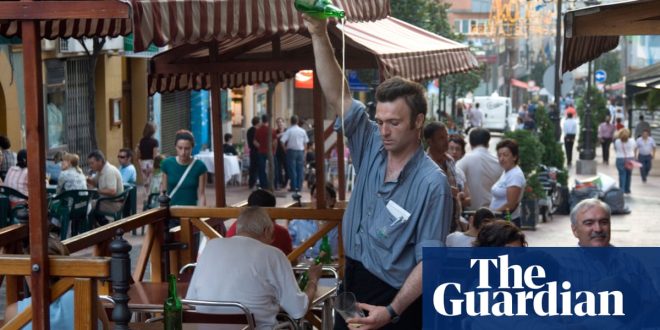As my train heads north-west from Madrid towards the green hills of Asturias, I eagerly await views of the lush landscape – but instead, I’m plunged into darkness. A new series of tunnels is leading me to the northern region’s capital, Oviedo, and among them is the seventh-longest in Europe: at 15 miles, it’s a complex work of engineering that cuts through the Cantabrian Mountains.
It’s much less scenic, but this new route – a €4bn (£3.4bn) infrastructure project launched last November – has reduced travel time between Madrid and Asturias by more than an hour, with an even shorter journey time expected later this year. The speedier connection means weekend breaks for madrileños and two-in-one holidays for visitors are more appealing than ever – not least for foodies drawn to the gastronomy of Spain’s greener, cooler regions.
Long traditions in fishing, livestock and agriculture in Asturias mean its seafood, meat, beans, corn, milk and cider are famed across Spain. Local dishes such as cachopo (breaded veal fillet stuffed with cheese and ham) and fabada (bean and pork stew) are common fare in Madrid too, at Asturian restaurants such as Casa Hortensia or El Ñeru – but the spotlight is now on Oviedo itself, named Spain’s gastronomy capital for 2024.
By the time I’ve checked into the Barceló Oviedo Cervantes hotel, in the chic, modern side of this compact city, I’m feeling hungry. It’s a short walk across San Francisco park leading to the old town, where I check out the single-towered gothic cathedral and soak up the atmosphere of its medieval plazas before hitting the cake shops for a range of traditional sweets: moscovitas (crisp almond and chocolate wafers) at Rialto and carbayones (glazed almond cream-filled pastries) at Camilo de Blas.
They’re delectable, but even more than its food, this part of Spain is best known for its cider. “The first cider of the year is smooth and refreshing,” says Andrés Alonso at Llagar Herminio, a cider press on the outskirts of Oviedo that was founded in 1943. He’s the third generation to run the family business and he shows me around the factory, from the machines that treat the apples to the fermenting and bottling process.
Home to more than 70 such mills, Asturias is one of the world’s largest producers of natural cider, which has protected denomination of origin status when made from any of 76 approved varieties of apple. The unique culture around Asturian cider – from production methods to drinking habits – is now being considered for classification by Unesco as intangible heritage.
Herminio is the only llagar (cider mill) in Oviedo but sidrerías (cider bars) are found all over – particularly on Calle Gascona, which local people call “Cider Boulevard”. El Ferroviario, La Manzana and La Finca are all good places to admire the art of escanciar (pouring from a great height). Alonso says the distance is crucial for producing a frothy, carbonated drink. “It’s full of molecules that have to burst,” he says, as a narrow jet shoots from the barrel’s spout. He he captures it in a glass held at arm’s length and angled so that the liquid bubbles on impact.
I swap cider for wine at La Corte de Pelayo, a restaurant in central Oviedo, tasting a white by Siluvio and a red by Monasterio de Corias, both local wineries. With views of the Asturias parliament and Plaza de la Escandalera, this classic spot offers traditional cuisine, thoughtful preparation and local produce ranging from fish such as alfonsino (red bream) and pixín (monkfish) to cachopo.
The restaurant’s owner, Lorena Martínez, says cachopo first emerged in the late 1940s, a local take on French veal cordon bleu. It was always considered rather basic comfort food, but Martínez wanted to make it more refined. The secret is in the ingredients, she says: a juicy, tender cut of veal; a suitably light cheese that doesn’t detract from the meat’s flavour; and Japanese panko breadcrumbs for the coating.
Whether finessing the classics or excelling in contemporary innovation, many chefs have been upping Oviedo’s game. Gloria is a smart dining house serving traditional dishes with modern flair – such as pitu de caleya (traditional free-range chicken), served either with rice or in rich cannelloni. It’s headed by Nacho Manzano, one of Asturias’s most-feted chefs and owner of the London chain Ibérica; he’s also just won a Michelin star for his fine dining restaurant NM, adding to his original two-starred Casa Marcial in the remote village of Arriondas, his birthplace.
At NM – an intimate space with just four tables – the tasting menu has 11 courses, all packed with flavour and texture. Hake from Avilés comes with a silky reduction made of its own collagen; squid strips and enoki mushrooms are wrapped in a casing of clotted milk; and the acidity of a sharp vinaigrette cuts the fat of a tender, salty pancetta. It’s a tribute to the region’s natural offering, too – the moss in the mushroom broth and the grass in the granizado (shaved ice) are meant to take diners through the woods and meadows of Asturias.
Longing for just such a rural setting, I take a 10-minute drive out of the city to Casa Chema, in a quiet spot overlooking pastures. In the kitchen, the head chef, Joaquina Rodríguez, is stirring a broth made of acorns – the same kind the region’s asturcelta pigs feast on. The chef also uses dried acorn flour to make tortos (crisp savoury cakes), to serve with slow-cooked pork ribs.
The most revered produce in this kitchen, however, is the faba, Asturias’s plump, white bean: Casa Chema serves about 2,300kg of them a year. “It’s hard to find a place in Asturias that does a bad fabada,” says Rodríguez, but I feel she is too modest – twice now, hers has been named the best in the world.
Beans are most commonly bought dried, but Rodríguez prefers fresh ones for their soft, pillowy texture; a good faba should melt, she says, when pushed into the roof of your mouth with your tongue. One by one, she pulls out the various pork pieces – belly, shoulder, morcilla (black pudding) and chorizo – that give the stew its rich flavour; she lifts another lid to reveal the pote asturiano, also a bean stew, but made with potato and cabbage.
There’s a vegan menu at Casa Chema too, including plant-based sausages and cheeses. But this part of Spain is paradise for dairy lovers, with more than 40 varieties of regional cheese. “Asturias is the Spanish Switzerland,” says the manager at Manduca Selección, a shop in Oviedo that works with locally renowned cheesemakers such as Rey Silo, Teyedu, Lazana and La Cueva de Llonín. I try an intense, punchy cabrales – usually matured in caves – as well as other varieties such as gamonéu, casín and afuega’l pitu. A similar selection can be enjoyed at tables in nearby wine bar Coalla, along with oysters, charcuterie, caviar and a glass of vino.
From its 250-mile coastline to the Picos de Europa mountains, the natural geography of Asturias is as diverse as its culinary produce. “There are many Asturiases within Asturias,” says Manzano. “Customs are different all along the coastal strip – and if you go just 5km inland, it’s like a different planet.” He adds that regions such as these – unlike Madrid and Catalonia – tend to experience greater culinary revolution outside their capital cities. He still wants me to make a pilgrimage to Arriondas – but in the meantime, he’s doing his bit to let Oviedo take centre stage.
Alvia trains from Madrid-Oviedo cost from €79.80 return, renfe.com; Barceló Oviedo Cervantes has doubles from €150 a night including breakfast, barcelo.com/es-es/barcelo-oviedo-cervantes/
 Top Naija News: Nigerian News, Breaking News Nigeria and World News Top Naija News is a daily news publication in Nigeria, delivering the latest breaking news in Nigeria and around the world.
Top Naija News: Nigerian News, Breaking News Nigeria and World News Top Naija News is a daily news publication in Nigeria, delivering the latest breaking news in Nigeria and around the world.




